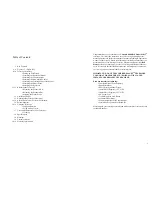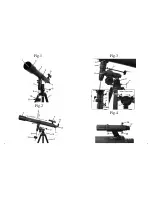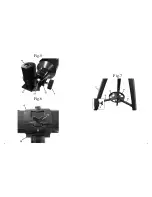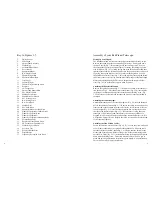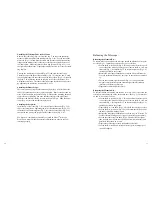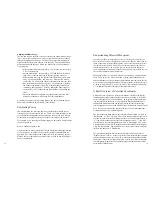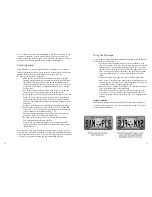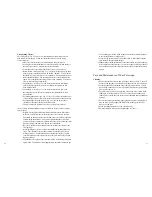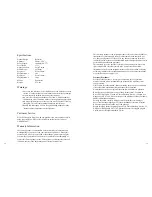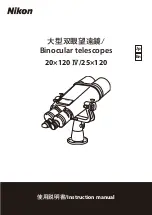
Aligning the Finder Scope:
The low power and wide field of view provided by the 6x30mm finder scope
(Fig. 1-5) provides a quick and easy way to sight an object prior to looking
through the high-power telescope. The finder scope must first be properly
aligned with the telescope in order to work properly. This alignment is best
performed during the daylight. Follow the steps below to align your finder
scope properly:
• Place the Plossl 20mm eyepiece (Fig. 2-14) into the corner lens (Fig.
2-15) of the telescope.
• Loosen both the R.A. lock knob (Fig. 3-22) and the Dec. lock knob
(Fig. 3-24) so that the telescope swings freely along both axes.
• Point the main telescope at a specific land object 200 yards or more
away. Lock down the R.A. and Dec. axes. Turn the slow motion
cables (Fig. 2–8,17) until the object is centered in the telescope field.
• Now look through the finder scope (Fig. 1-5) and loosen or tighten
the finder scope bracket screws (Fig. 4-26) until the crosshairs are
centered on the same object. Focus by turning the finder scope fo
-
cus knob (Fig. 4-27) until the image in the finder scope is sharp and
clear.
• Check the alignment at nighttime by repeating this process with a
bright star or the moon. Make any necessary adjustments.
Now that your finder scope is properly aligned, any object centered in your
finder scope should also be centered in your telescope.
Calculating Power:
The magnification of a telescope depends on both the focal length of your
telescope as well as the eyepiece you use. There is a simple formula you can
use to determine the magnification you are using at any given time. Simply
divide the focal length of the telescope by the focal length of the eyepiece.
For example, if you are using the 20mm eyepiece with your TP-400 telescope
the power would be:
Power = 1000mm / 20mm = 50x
Using an eyepiece with a smaller focal length will increase the magnification
of your telescope. It is always best to start at the lowest magnification con
-
figuration. The wider field of view makes it easier to spot far away objects.
Once an object is centered in your field of view you can switch to the higher
power configurations.
Understanding Celestial Movement:
In order to get the most enjoyment out of your telescope it is necessary to
know the basics of how celestial objects move across the sky. Due to the ro
-
tation of the earth, celestial objects appear to move from East to West across
the sky, much like the Sun. You will notice this movement as an object in
your telescope field of view will slowly move across the field and out of
view. Continuous adjustment is needed to keep an object in the field of view.
This will be explained in more detail later.
Many people choose to “star-hop” when using a telescope, a quick and rela
-
tively easy way to start. This is a method of using easily identifiable stars
and constellations to serve as reference points to find other objects in the sky.
A more advanced and precise method of locating specific celestial objects is
by using setting circles (Fig. 3-20,21) located on your equatorial mount (Fig.
1-7) to find the celestial coordinates of that particular object.
A Brief Overview of Celestial Coordinates:
Astronomers use a system of “celestial coordinates” similar to the Earth’s
latitude and longitude system to help locate objects in the sky. All celestial
objects are mapped on a “celestial sphere”, an imaginary sphere of arbitrary
size concentric with the Earth. If you extend the Earth’s rotational axis to
infinity, both North and South, the points at which this axis intersects the
celestial sphere are known as the North Celestial Pole and the South Celestial
Pole. If you project the Earth’s equator outward to the celestial sphere this
would be known as the “Celestial Equator”.
The equivalent to latitude lines on the celestial sphere are known as lines of
“Declination”, or “Dec.” for short. These lines are measured in degrees, min
-
utes and seconds. Declination readings north of the celestial equator carry a
“+” sign, while readings south of the celestial equator carry a “-“ sign. Ob
-
jects located on the celestial equator have a 0°0’0” Declination. The North
Celestial Pole has a +90°0’0” Declination while the South Celestial Pole has
a -90°0’0” Declination. The star Polaris is located very near the North Celes
-
tial Pole and has a +89.2° Declination.
The equivalent to longitude lines on the celestial sphere are known as lines of
“Right Ascension” or “R.A.” for short. These lines are measured in hours, minutes
and seconds starting at the “zero” line of R.A. which passes through the constella
-
tion Pegasus. There are 24 primary lines of R.A. located at 15° intervals along the
celestial equator. Right Ascension coordinates range from 0hr 0min 0sec to (but
not including) 24hr 0min 0sec.
13
12
Summary of Contents for RP-400
Page 3: ...Fig 1 Fig 3 Fig 2 5 4 Fig 4...
Page 4: ...Fig 6 Fig 5 Fig 7 7 6...


